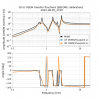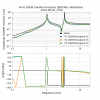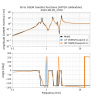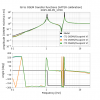This errata is the SR3 version of [LHO: 87160] that dealt with PR3.
While double-checking the PR3/SR3 OSEM calibration script, I noticed a typo on the printing output of the function that generated the logpost [LHO: 85907].
No changes need to be made because the calculated M1 OSEM calibrations and M1_DAMP gains are both correct. Plots and other visual documentation is all correct too.
However, the expected alignments posted in [LHO: 85907] were wrong, as the (old EUL) to (new EUL) transformation matrix was accidentally inverted.
I post here the corrected script output for the SR3 OSEM calibration for the sake of documentation and transparency. Note that the theoretically calculated alignment values match the observed ones for SR3 too [see attached screenshot]
_____________________________________________________
OSEM calibration of H1:SUS-SR3
Stage: M1
2025-07-22_1530 (UTC).
The suggested (calibrated) M1 OSEMINF gains are
(new T1) = 2.174 * (old T1) = 3.213
(new T2) = 1.610 * (old T2) = 1.517
(new T3) = 1.569 * (old T3) = 1.494
(new LF) = 1.331 * (old LF) = 1.733
(new RT) = 1.374 * (old RT) = 1.494
(new SD) = 1.390 * (old SD) = 1.793
To compensate for the OSEM gain changes, we estimate that the H1:SUS-SR3_M1_DAMP loops must be changed by factors of:
L gain = 0.740 * (old L gain)
T gain = 0.719 * (old T gain)
V gain = 0.545 * (old V gain)
R gain = 0.545 * (old R gain)
P gain = 0.629 * (old P gain)
Y gain = 0.740 * (old Y gain)
The calibration will change the apparent alignment of the suspension as seen by the at the M1 OSEMs
NOTE: The actual alignment of the suspension will NOT change as a result of the calibration process
The changes are computed as (osem2eul) * gain * inv(osem2eul).
Using the alignments from 2025-07-22_1530 (UTC) as a reference, the new apparent alingments are:
DOF Previous value New value Apparent change
---------------------------------------------------------------------------------
L -5.0 um -7.7 um -2.8 um
T -21.6 um -30.0 um -8.4 um
V 11.8 um 10.6 um -1.2 um
R -576.3 urad -1036.9 urad -460.6 urad
P -266.5 urad -447.4 urad -180.8 urad
Y -585.0 urad -792.6 urad -207.6 urad
We have estimated a OSEM calibration of H1 SR3 M1 using HAM5 ST1 drives from 2025-05-21_0000 (UTC).
We fit the response M1_DAMP/HAM5_SUSPOINT between 5 and 15 Hz to get a calibration in [OSEM m]/[GS13 m]
This message was generated automatically by OSEM_calibration_SR3.py on 2025-09-26 21:16:58.591270+00:00 UTC
%%%%%%%%%%%%%%%%%%%%%%%%%%%%
EXTRA INFORMATION
The H1:SUS-SR3_M1_OSEMINF gains at the time of measurement were:
(old) T1: 1.478
(old) T2: 0.942
(old) T3: 0.952
(old) LF: 1.302
(old) RT: 1.087
(old) SD: 1.290
The matrix to convert from the old Euler dofs to the (calibrated) new Euler dofs is:
+1.353 +0.0 -0.0 +0.0 -0.0 +0.002
+0.0 +1.39 +0.0 -0.0 -0.0 +0.0
+0.0 +0.0 +1.882 +0.02 -0.0 -0.0
+0.0 -0.0 +4.175 +1.882 +0.007 +0.0
-0.0 -0.0 -0.454 +0.032 +1.59 +0.0
+0.27 -0.0 -0.0 +0.0 +0.0 +1.353
The matrix is used as (M) * (old EUL dof) = (new EUL dof)
The dof ordering is ('L', 'T', 'V', 'R', 'P', 'Y')




















































